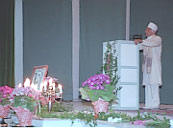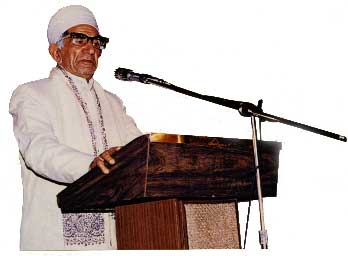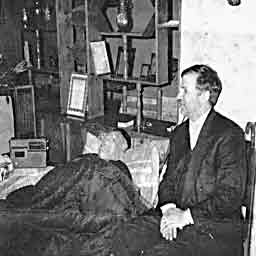|
An
embodiment of enlightenment, courage and dedication
 |
|
Late Mobedan-e-Moden Rostam
Shahzadi delivering the keynote speech on Zarathushra's birthday, March
26, 1999 |
“Nov-Ruz is our heritage
going back in millennia. It bears testimony to the positive outlook of
ancient Zarathushtrian, and symbolizes the fact that they believed in
living happily and righteously. Festivities were held at least once a month,
and three of these were more prominent than the others. Nov-Ruz, at the
beginning of the spring in the Northern hemisphere, Mehrgan in the first
month of autumn and Sadeh in mid winter.
We, Iranians can claim
inheritance to a national treasure based on the civilization of ancient
Iran. It is the duty of each and every single Iranian regardless of their
dialect and religious belief to collectively and unanimously help the land
of our ancestors, the Motherland of Iran, to become progressive and to
succeed in all aspects of its national existence. This is to make Iran
strong, prestigious and respectable, as she deserves to be."
The above encouraging
words, were delivered by Mobedan-e-Mobed Rostam Shahzadi, on Nov-Ruz of
1369YZ (3738 Zarathushtrian, 2000 A.C.) to the community several days prior
to his death.
Mobed Rostam was not
simply a mobed for the Iranian Zarathushtrian community; he was a recognized
national figure, a man who helped the Zarathushtrians in social, cultural
and religious matters. He encouraged people to use their innate "Good Minds"
and utilize this unlimited creative power to resolve problems and issues.
 |
|
Rostam Shahzadi delivering
a speech two years before his demise.. |
His presence in any
gathering was memorable. Many Zarathushtis recall some significant events in
their lives involving Rostam Shahzadi. Young and old couples who started
their married lives benefited with "Good Words" of wisdom
from Mobed Rostam. People got solutions to their marital
or other problems by seeking his guidance. All this indicates that the well
celebrated Mobedan-e-Mobed Iran of the 1990 decade led a productive life of
dedication and service.
Mobed Rostam was born in
a devout Zartoshty family in 1281 YZ, in Yazd, Iran. His father, Mobed
Dinyar was himself a respected man, who served his community by executing
priestly duties. Mobed Rostam completed his elementary studies at Dynyari
Zartoshty School for boys in Yazd and went on to Tehran to undertake and
complete his high school at the famed Alborz high school for boys which was
run by an American organization.
Rostam and his classmate
Firooz Azargoshasb were offered scholarships by the "Kankash-e-Mobedan of
Yazd" (Council of Mobeds) to study with the renowned Gathic scholar Dr. Iraj
Taraporwala in Mumbai, India.
The young Mobed Rostam
spent seven years in India studying the Gathas, understanding religious
practices and became conversant in the Avestan, Pahlavi and Pazand
languages. Upon completion of his schooling, Rustom was granted the honor
of "High Mobed." Upon graduation, he left India for his beloved homeland
and served two years of the mandatory national service as a military
conscript. His familiarity with the English language and the knowledge of
the law made him a great asset to the Iranian army where he served for two
years. His exceptional service earned him a promotion to the rank of
lieutenant before his term of duty was over.
For two years, Mobed
Rostam taught religious courses along with English, History and Geography to
young students at Markar high school in Yazd. At the same time he helped the
"Kankash e Mobedan e Yazd" in religious matters. All along he kept active in
delivering public lectures and providing information on matters relating to
the Zarathushtrian religion. His contribution in spreading the Gathic
message was very noteworthy, and he proved to be a great asset to the
Zartoshty community of Yazd.
In 1315 YZ, Mobed
Rostam, by then married and having had his first child, moved with his
family to Tehran, in response to an invitation from the Zarathushtrian
Association of Tehran. Three years later, in 1328 Mobed Rostam graduated
from the College of Law of Tehran University which furthered his abilities
to serve his nation and the Zarathushtrian community of Iran.
His services to the
community as one of the senior Zarathushtrian priests of Tehran, included
teaching religion classes at Zarathushtrian high schools to the youth,
managing the co-ordination of the library of the late Ardeshir Yeganegi and
teaching English language at Tehran high schools. He also delivered hundreds
of lectures at national, cultural, historical and religious ceremonies as a
member of the "Kankash e Mobedan e Tehran", representing the Zarathushtrian
community at the Royal court at Nov-Ruz receptions. After the Islamic
revolution in Iran, Mobed Shahzadi represented the community at the Majlis
Khobrakhan, which was set up to rule on various national agenda. When the
issue of changing the colors of the national flag was raised, a passionate
speech from Mobed Shahzadi saved the day for Iranian national pride, and the
colors were left unchanged.
Mobed Rostam’s role in
educating people on the Gathic vision was noteworthy, and he took it upon
himself to respond to thousands of enquiries from all people
interested in Zarathushtra’s message and other religious
matters. He authored hundreds of articles that were published in various
journals during his life.
Another essential
service that Mobed Rostam provided was that of being the chief marital
counselor for the Zarathushtrian community. This was particularly
significant as Mobed Rostam had studied Law, and his knowledge and
experience proved invaluable to untold number of young couples who sought
his advice.
Mobed Shahzadi played a
critical role as a member of the first "Khobregan" assembly after the
Islamic revolution in Iran, where he defended the rights of not only
Zarathushtrians but of all the religious
minorities of Iran. His dedication and courage in effect made him the
single representative of all the minorities in that Islamic constitutionsal
body.
Mobed Rostam was a
selfless dedicated person who made many short and long trips, trying to help
his people to understand their proud heritage and honorable religion. Many
non-Zarathushtrians who wanted to know more about the rich heritage of their
ancestors would seek his insights on historical, cultural
and religious matters.
Mobed Rostam in his
fruitful life participated in many national and international congresses
around the world. Amongst his writings one can find:
-
"The
Vision of Zarathushtra,” published in 1357 YZ
-
"The
Translation of Gathas,” in 1367
-
A Look
into the Gathas
-
"Zarathushtrianism
is Monothestic” in 1354
-
An
Analysis of Zarathushtra's Teaching by Tahmoras Sethna, 1344
-
"A Look
into Marriage Laws in Ancient
Iran” by Jamshid
Kavoos Katrak, 1332
-
"The
Alphabet of the Avesta" (A book on Avestan Language and Farsi
Pronunciations)
-
"The Civil
Code of Zarathushtrians of Sassanin era,” 1355. This article was based
on his thesis to satisfay the requirements of his graduation from the
University of
Tehran, School of Law.
-
“Passages
from the Avesta for the Young Zarathushtrians,” 1337
-
“The
Avestan prayers for the departed with commentaties in Farsi,” 1319
-
Series of
Religious Booklets for education of young adults
-
“Zarathushtra and his Teachings”
-
“Translation of the work of the late Dastur Manekji Dhala on
Understanding God from a Zarathushtrian Perspective”
-
“The
Literature of Pahlavi, Pazand and Faris Dari”
Mobed Rostam lived a
fruitful life of 88 years. Upon his demise, several scholars and other
prominent Iranians spoke about his distinguished life of service and
dedication to his community and nation.
The words spoken by
Dr. Hussain Vahidi were typical.
"I have known Mobed
Rostam for many years, and have come to the conclusion that he is a true,
righteous man, a man whose character description has been sketched in the
Gathas of Zarathushtra, a man who had a deep knowledge of Zarathusthtra’s
vision. Overall he possessed a great vision, and in a few words was a man
of the Gathas. Mobed Rostam had no prejudices and knew Zarathushtra by time
and in time. I got to know Mobed Rostam when I was a student at the College
of Law and needed to get some information about the Zartoshti religion. He
helped me graciously and shared all his books with me."
Dr. Muhammad Ali Islami
Nedooshan writes "I only saw him once, but I had heard about him. I have
read his translation of the Gathas which I found very valuable".
The well recognized
mathematician, Ostad Parviz Shahriari wrote "I knew Mobed Rostam since I met
him in the Zarathushtrian Anjuman of
Tehran many years ago.
He was very clear and spoke very eloquently leaving no ambiguity on any
topic. He shared with kindness whatever was in his heart".
Dr. Khosro Dabestani,
the representative of the Zarathushtrian community in the parliament of the
Islamic republic of Iran in 1999, wrote "Mobed Rostam was a great
personality of the Zarathushtrian community of Iran. I met him for the
first time at Kankash-e-Yeganegi. What was impressive about him through to
the last days of his life was his dedication to educating our society and
informing us all about our proud and profound heritage.”
Professor Farhang Mehr
indicates the late Mobed was versed in Avestan languages with scholarly
knowledge of the Gathas and mastery of comparative religions. “As such he
was well qualified to communicate and disseminate the teachings of
Zarathushtra. Mobed Shahzadi was progressive and visionary. I recall his
enthusiasm in teaching Zarathushtrianism to the self-converted groups in
Abadan, Khuzastan, and his earnest desire to travel to Klanaghan, Iraq to
teach Avesta to Yazidis (Kurdish group) at their request.
As a mobed he championed
the people’s right to freedom of choice for their religion, and was willing
to spend as much time as needed to answer their religious enquiries. He
truly practiced what he preached.
His services to Iran and
the Zarathushtrian community were invaluable. He represented the
Zarathushtrian community in the “Majlis-e-Khobragan” that was charted with
adapting the constitutional laws of Iran. During a debate on the colors and
insignia of the national flag, despite the prevailing fanaticism, Mobed
Shahzadi succeeded in persuading the Majlis to retain the traditional three
colors of green, white, and red but failed to save the insignia of lion and
sun. Mobed Shahzadi was a noble Iranian Zarathushti who left a rich legacy
for future generations.”
 |
|
Iranian minister of
education, Mohajerani, rushed to visit Rostam Shahzadi hearing of his
illness few days before Mobedan-e-Mobed passed away. |
His knowledge and
enlightenment won him respect from many who met him. Dr. Mahmud
Rouh-ul-Amini, professor of anthropology at Tehran University once related
his experience of taking his class on a field trip to the Zarathushtrian
Anjuman complex in Tehran. After the tour of the complex, the students sat
down with Mobed Shahzadi, and were so taken by Mobed’s knowledge, and
foresight, that they lost truck time. Mobed Shahzadi left a lasting
impression on them.
The last testimonial to
a life well lived comes from the late Mobed Rostam’s oldest child Mehrangiz
Shahzadi. She could best describe her father as a true human being with a
deep passion for helping others regardless of their religious belief, race
or gender. He valued humanity irrespective of man made barriers, and there
was a special place in his heart for Iran, the birth place of “Good
Thoughts, Good words, Good Deeds”.
May the example set by
his life of service and enlightenment inspire others, and may he be blessed
in the Abode of Songs. |